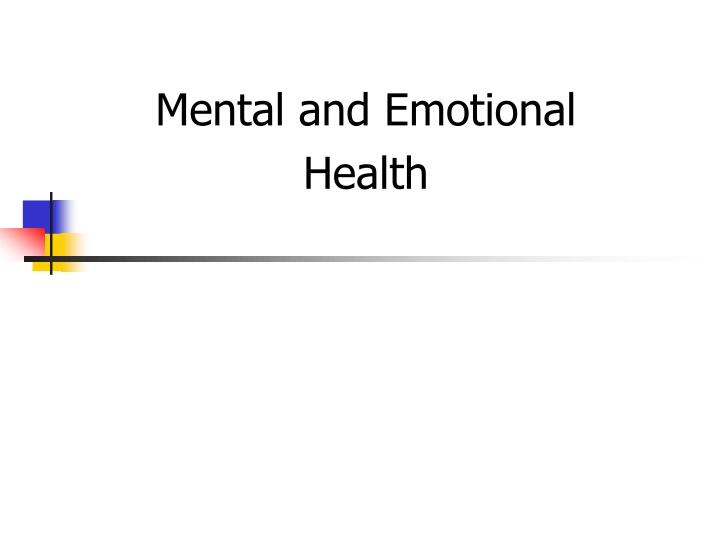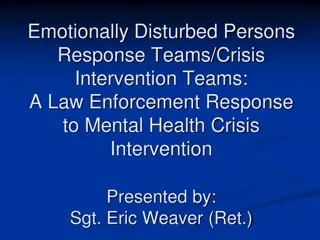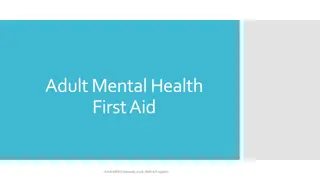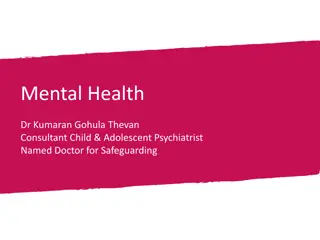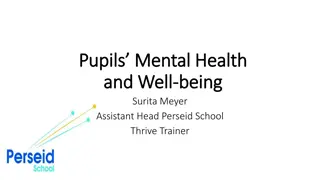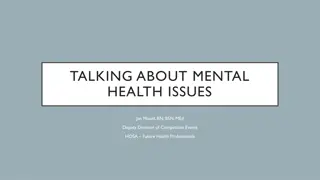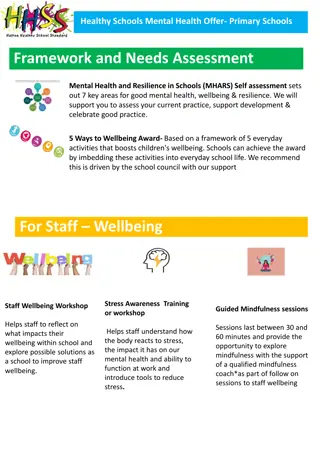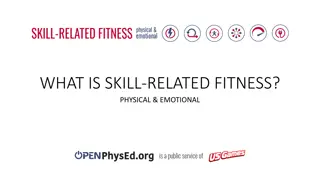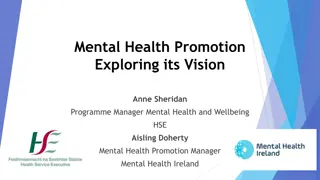Mental and Emotional Health
Mental and emotional health are crucial aspects of overall well-being. This content explores various emotions such as love, happiness, optimism, fear, anger, guilt, jealousy, along with feelings like loneliness, shyness, and depression. It also provides insight into managing these emotions effectively, promoting a positive outlook on life.
Download Presentation

Please find below an Image/Link to download the presentation.
The content on the website is provided AS IS for your information and personal use only. It may not be sold, licensed, or shared on other websites without obtaining consent from the author.If you encounter any issues during the download, it is possible that the publisher has removed the file from their server.
You are allowed to download the files provided on this website for personal or commercial use, subject to the condition that they are used lawfully. All files are the property of their respective owners.
The content on the website is provided AS IS for your information and personal use only. It may not be sold, licensed, or shared on other websites without obtaining consent from the author.
E N D
Presentation Transcript
Mental and Emotional Health
Mental Health The feeling you have about yourself and your abilities to deal with problems
Emotions Normal Everyone has them Express them in a positive way (not negative)
Emotions Examples Love strong affection or caring for someone. Happiness feeling of joy and well being or contentment.
Optimism feeling that life experiences will be positive. Humor a way of expressing some negative emotions in a more positive way.
Fear feeling of danger Managing your fears Self talk saying things to yourself to view the fear more realistically. Environmental planning rearranging the environment to reduce your fear.
Anger strong feeling or irritation. Managing anger Channel emotions appropriately, so that they are positive Recognize your feelings and the source of the anger
Guilt feeling that you have done something wrong or are responsible for something bad happening. Jealousy feeling of wanting something that someone else has or of losing something you have
Loneliness feeling of isolation or alienation Shyness- being timid or bashful
Depression feeling of sadness loneliness and despair. Family History Major life stressors Physical illness Substance abuse Gender
Managing depression Try to identify your source of depression Put things into perspective Focus on the positive things Talk to someone you trust
Self ideal - your mental image of what you would like to be Self concept the current mental image you have of yourself.
Defense Mechanisms Techniques people use to protect themselves from being hurt. Page 160
Maslows Hierarchy of Needs focusing on the positive aspects of human behavior. He organized human need by priority
Self Actualization Personal growth and fulfillment Esteem needs Achievement, responsibility, reputation Belongingness and love needs Family affection, relationships Safety Needs Protection, security, law and order Biological and physiological need Basic life needs- air, food, shelter, sleep
Types of Mental and Emotional Disorders
Organic disorder mental and emotional disorders resulting from a physical cause. Physical illness- brain tumor injury blow to the head chemical imbalance drugs to destroy brain cells
Eating Disorders deep emotional problems related to self image and self- esteem Required psychiatric treatment Increased among teens
Anxiety disorder a condition in which fear or anxiety prevents one from enjoying life and completing everyday task. Most common Phobias most well know More women then men
Dissociative disorder a condition in which someone s personality changes to the point that the person believes he or she is someone else Amnesia Multiple personality disorder
Mood Disorder a condition in which one mood is experienced almost to the exclusion of other feelings depression
Personality Disorder an emotional condition in which a person s patterns of behavior negatively affects that person s ability to get along with others. Antisocial
Somatoform Disorder emotional condition in which there are physical symptoms but no identifiable disease or injury, physical symptoms are caused by psychological factors. Hypochondria
Seeking Help IF You Have prolonged feeling of depression or hopelessness Feelings that life is out of control Inability to concentrate or make decisions. Difficulty getting along with others
Cont. Intense fears Persistent difficulty sleeping Emotional problems coping with a physical illness Inability to stop destructive behaviors
Types of Treatment Psychoanalysis examines unresolved conflict from the past. Behavior therapy focuses on the persons behavior now rather then the underlying problem.
Cont. Group Therapy- meetings of people with similar problems. Chemical Therapy the use of drugs to treat mental and emotional disorders. (can be dangerous and addictive)
Self Esteem pride in and acceptance of yourself; feeling good about yourself and your abilities. Begins at Birth
Body Image the view a person has on his or her body Positive self talk talking in a positive way to yourself about yourself. Self disclosure telling another person meaningful info about yourself
10 Steps to Improve Self-Esteem 1. Think about what you are good at, and build on those abilities 2. Select supportive and encouraging friends 3. Practice good health habits
4. Exercise!!!!!!!!! 5. Think positive Write down 3 things that make you happy everyday Set goals, be realistic Beware of perfectionist
Make a difference in the world, help others *Volunteer Reward yourself Have fun !!!!!!!!!!!!!!!!!
Self Esteem more than any other factors has a direct effect on all 5 aspects of your health
This powerpoint was kindly donated to www.worldofteaching.com http://www.worldofteaching.com is home to over a thousand powerpoints submitted by teachers. This is a completely free site and requires no registration. Please visit and I hope it will help in your teaching.
